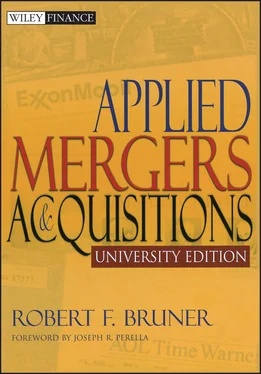PRODUCTIVITY STUDIESAnother line of research is to consider the impact of diversification or focus on the productivity of business units and plants. Lichtenberg (1992) found lower total factor productivity with increases in diversification. But Schoar (2002) reported that plants in diversified firms were 7 percent more productive than plants in single-business firms. Nevertheless, increases in diversification are associated with a net decrease in productivity. Plants that had been acquired actually increased their productivity, whereas incumbent plants decreased in productivity—but since there were fewer acquired than incumbent plants, the total effect on productivity was negative. Schoar wrote, “Diversified firms experience a ‘new toy’ effect, whereby management focus shifts towards new segments at the expense of existing divisions. As a whole, these results indicate that diversified firms have a productivity advantage over their stand-alone counterparts. They even increase the productivity of their acquired assets. With each diversifying move, however, these firms lose some of their productivity advantage.” (Page 2380)
PROPENSITY TOWARD DIVESTITURESScholars have studied the characteristics of those firms that undertake divestment. Porter (1987) and Ravenscraft (1987) found that divestiture follows acquisition: Firms may buy, but are not assured of retaining their purchases. Their reading was that growth through acquisition was not a stable growth strategy. Weston (1989) offered the rebuttal noted earlier. Kaplan and Weisbach (1992) found that firms were more likely to divest unrelated acquisitions than related acquisitions, suggesting that unrelated acquisitions don’t pay.
STUDIES OF LONG-TERM REPORTED FINANCIAL RESULTSThough accounting results are easily “managed” by executives and are vulnerable to exogenous effects unrelated to diversification, they are an ongoing focus of investigation. Four studies 13 showed that firms following strategies of unrelated diversification underperform those firms who focus more. Yet four other studies 14 found improvements in operating performance following diversifying acquisitions. In addition, Anslinger and Copeland (1996) found that firms pursuing a conscious strategy of unrelated diversification have realized high abnormal returns for sustained periods. Baker and Smith (1998) documented high absolute returns to Kohlberg, Kravis, and Roberts, a well-known leveraged buyout firm and owner of a diversified portfolio of industrial interests. Fluck and Lynch (1999) presented a model of corporate strategy in which both diversifying acquisition and then focusing divestiture create value: This relies on the existence of positive net present value (NPV) projects that are unable to obtain financing in public markets. The large firm acquires, finances, grows, and then divests these businesses profitably. In sum, it seems that diversification or focus may not help to discriminate among firms on the basis of long-term performance. Anslinger and Copeland (1996) argued that it is the postacquisition management strategy and structure, rather than the strategy of diversification or focus, that matters in producing long-term performance.
Practical Implications of the Research Debate over Diversification versus Focus
How are we to make sense of these disparate and contradictory findings? Villa-longa (2003b) argues that the debate revolves around three categories of tests, of differing strength. Like the old research on capital market efficiency, there are three forms of assertions about whether diversification destroys value:
1 Weak form. Does the diversified firm trade at a discount relative to stand-alone businesses in the same industry? The evidence is mixed here, and the more recent studies favor “no” as an answer.
2 Semistrong form. Does the diversified firm trade at a discount relative to its “bust-up” value? A positive answer here asserts that the diversified firm destroys value by staying diversified, and is supported by the numerous studies finding that value is created when firms divest, spin off, or carve out their businesses. Villalonga (2003b) writes, “When firms are outperformed by their competitors, any change in their current strategy is welcomed by the stock market. There is as much evidence that firms are destroying value by staying diversified as there is evidence that single-segment firms are destroying value by not diversifying.” (Page 4)
3 Strong form. Does the diversified firm trade at a discount relative to what it would be worth if it had not diversified? A positive answer here asserts that the act of diversification destroys value. Unfortunately, this “had not diversified” value is unobservable and efforts to find an implied value are challenged by a strong selection bias: Firms that diversify are found to be significantly different from those that don’t.
The conclusion from this survey is that one cannot confidently condemn diversification or endorse focus. Still, the research holds some useful implications for the practitioner.
DIVERSIFY ONLY WITH A SOUND ECONOMIC RATIONALEEven if there is no diversification discount, the distribution of outcomes is large, meaning that a nontrivial portion of diversifiers destroy value. The solution is to use an economics perspective to guide your strategic planning and transaction design. The research shows that diversification may be successful under certain circumstances.
Where there is high relatedness in terms of industry focus between the target and buyer. Richard Rumelt (1974, 1982) found that returns on equity were higher for strategies of related diversification than for strategies of unrelated diversification or for single-business focus.
Where the internal markets for talent and capital are truly disciplined, and managers are properly rewarded. Studies by Amihud and Lev (1981) and Denis et al. (1997) suggest that diversification imposes a kind of agency cost: Manager-controlled firms do more diversifying deals than shareholder-controlled firms. 15 Anslinger and Copeland (1996) studied 21 firms with little or no internal relatedness, and found that they produced returns of 18 to 35 percent per year by making nonsynergistic acquisitions. They explained the superior performance of these firms as due to seven principles: “Insist on innovating operating strategies. Don’t do the deal if you can’t find the leader. Offer big incentives to top-level executives. Link compensation to changes in cash flow. Push the pace of change. Foster dynamic relationships among owners, managers, and the board. Hire the best acquirers.” ( Page 127)
Where the public capital market is less effective. Hubbard and Palia (1999) found that returns from conglomeration were positive and significant during the 1960s, a time when the authors believed the U.S. capital markets were less efficient in allocating capital than they are today. Khanna and Palepu (1997, 2000) made a similar argument in studying conglomerates in India. The authors concluded that these industrial groups enjoyed greater efficiency because of their ability to allocate resources better than the capital market there. And Fauver, Houston, and Naranjo (2002) studied 8,000 companies in 35 countries, concluding, “Internal capital markets generated through corporate diversification are more valuable (or less costly) in countries where there is less shareholder protection and where firms find it more difficult to raise external capital.” ( Page 1) The distinction between developed and developing countries is therefore interesting as a possible focus for diversification strategies. The research of Lins and Servaes (1999, 2002) lends such a comparison. They found a diversification discount of zero percent in Germany, 10 percent in Japan, and 15 percent in the United Kingdom. But in seven emerging markets, they found a diversification discount of about 7 percent, and concluded that the discount was concentrated among firms that are members of industrial groups. This contradicts the idea that diversification pays where public markets are less efficient, and suggests that differences in corporate governance and/or rule of law across countries may have a material impact on the benefits of a diversification strategy.
Читать дальше












